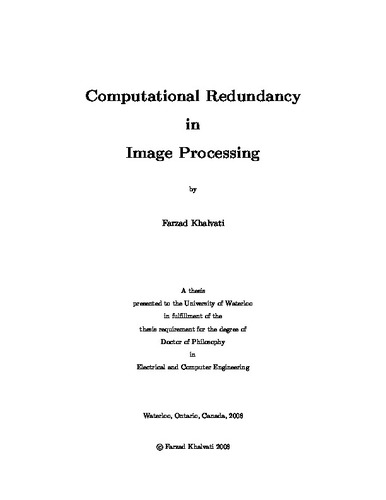| dc.contributor.author | Khalvati, Farzad | |
| dc.date.accessioned | 2008-12-19 16:56:37 (GMT) | |
| dc.date.available | 2008-12-19 16:56:37 (GMT) | |
| dc.date.issued | 2008-12-19T16:56:37Z | |
| dc.date.submitted | 2008 | |
| dc.identifier.uri | http://hdl.handle.net/10012/4151 | |
| dc.description.abstract | This research presents a new performance improvement technique, window memoization, for software and hardware implementations of local image processing algorithms. Window memoization combines the memoization techniques proposed in software and hardware with a characteristic of image data, computational redundancy, to improve the performance (in software) and efficiency (in hardware) of local image processing algorithms.
The computational redundancy of an image indicates the percentage of computations that can be skipped when performing a local image processing algorithm on the image. Our studies show that computational redundancy is inherited from two principal redundancies in image data: coding redundancy and interpixel redundancy. We have shown mathematically that the amount of coding and interpixel redundancy of an image has a positive effect on the computational redundancy of the image where a higher coding and interpixel redundancy leads to a higher computational redundancy. We have also demonstrated (mathematically and empirically) that the amount of coding and interpixel redundancy of an image has a positive effect on the speedup obtained for the image by window memoization in both software and hardware.
Window memoization minimizes the number of redundant computations performed on an image by identifying similar neighborhoods of pixels in the image. It uses a memory, reuse table, to store the results of previously performed computations. When a set of computations has to be performed for the first time, the computations are performed and the corresponding result is stored in the reuse table. When the same set of computations has to be performed again in the future, the previously calculated result is reused and the actual computations are skipped.
Implementing the window memoization technique in software speeds up the computations required to complete an image processing task. In software, we have developed an optimized architecture for window memoization and applied it to six image processing algorithms: Canny edge detector, morphological gradient, Kirsch edge detector, Trajkovic corner detector, median filter, and local variance. The typical speedups range from 1.2 to 7.9 with a maximum factor of 40. We have also presented a performance model to predict the speedups obtained by window memoization in software.
In hardware, we have developed an optimized architecture that embodies the window memoization technique. Our hardware design for window memoization achieves high speedups with an overhead in hardware area that is significantly less than that of conventional performance improvement techniques. As case studies in hardware, we have applied window memoization to the Kirsch edge detector and median filter. The typical and maximum speedup factors in hardware are 1.6 and 1.8, respectively, with 40% less hardware in comparison to conventional optimization techniques. | en |
| dc.language.iso | en | en |
| dc.publisher | University of Waterloo | en |
| dc.subject | Image Processing | en |
| dc.subject | Performance Optimization in Software and Hardware | en |
| dc.subject | Pipelined Image Processing Circuitry | en |
| dc.subject | High-Performance Image Processing | en |
| dc.title | Computational Redundancy in Image Processing | en |
| dc.type | Doctoral Thesis | en |
| dc.pending | false | en |
| dc.subject.program | Electrical and Computer Engineering | en |
| uws-etd.degree.department | Electrical and Computer Engineering | en |
| uws-etd.degree | Doctor of Philosophy | en |
| uws.typeOfResource | Text | en |
| uws.peerReviewStatus | Unreviewed | en |
| uws.scholarLevel | Graduate | en |

